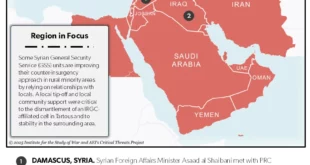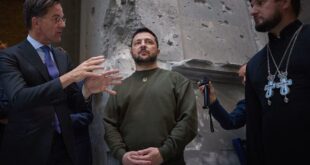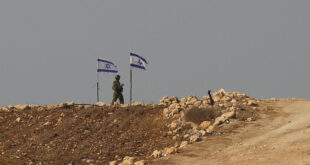The July election of reformist President Masoud Pezeshkian and historic fears of conflict with the U.S. military have delayed or derailed an Iranian retaliatory attack on Israel.
Iranian leaders appear willing to trade a military response to the killing in Tehran of Hamas leader Ismail Haniyeh for an indirect seat at the table in Gaza ceasefire talks.
Strategically, another missile and drone barrage against Israel that is intercepted by Israel and a U.S.-led coalition would paint Tehran as regionally weak and unable to protect its “Axis of Resistance” partners.
Internal turmoil surrounding Pezeshkian’s cabinet nominees reflects divisions within Iran over Iran’s regional and global foreign policy strategy.
Since the July 31 assassination of Hamas’ top leader in Tehran, an operation by all accounts conducted by Israeli intelligence, Iran has vowed to conduct a major retaliatory attack on Israel, presumably including a large missile and armed drone barrage similar to the attack by Iran on April 13. Iran’s closest regional ally, Lebanese Hezbollah, has similarly pledged retaliation for the nearly simultaneous Israeli airstrike on Beirut that killed Fuad Shukr, a senior commander of the organization’s military wing. Global experts always expected Iran and Hezbollah to carefully calibrate their retaliatory actions to avoid sparking a regional war, particularly involving clashes with the U.S. military.
Yet, three weeks since the Haniyeh assassination, neither Iran nor Hezbollah has launched major attacks on Israel. This delay suggests Iranian and Hezbollah leaders are uncertain about the consequences of their promised strike. Iranian leaders are indicating they might be willing to further postpone or cancel outright a retaliatory attack if U.S. leaders are able to meet Iran’s demand for an immediate ceasefire agreement in the Gaza war. Iranian leaders have indicated they will evaluate the outcome of a renewed U.S.-led push for a Gaza ceasefire as talks are set to reconvene in Cairo this week. Iran’s linkage of its attack to a Gaza ceasefire would indicate that Iranian leaders might have gained a long-sought “seat at the table” in Israeli-Palestinian negotiations after decades of sidelining at the hands of the United States, Israel, and the Arab states.
Iran’s more immediate goals in offering to stand down if a Gaza ceasefire is reached appear obvious. Using the threat of retaliation if ceasefire talks fail, Iran is placing pressure on U.S. officials to compel Israeli Prime Minister Binyamin Netanyahu to accept Hamas’ demands for a full withdrawal from the enclave. An end to the Israeli offensive would enable Hamas to survive politically and militarily, even if it has been dramatically weakened by the Israel Defense Forces (IDF). Iran, and its ally, the newly named top Hamas leader Yahya Sinwar, assess that even a weakened Hamas can eventually rebuild its military and political network and return to power in Gaza and regain its place as an effective and active member of Iran’s “Axis of Resistance”. Hamas’ ability to pressure Israel militarily with rocket and missile fire has been pivotal to Iran’s “unity of fronts” strategy, and the full elimination of Hamas would significantly set Iran back strategically.
Tehran’s delay and potential cancellation of a retaliatory attack also appears to be taking into account the regional balance of power and historic Iranian fears. In several official statements and press briefings, senior U.S. officials have messaged Tehran that the U.S. is committed to helping defend Israel against an Iranian retaliatory barrage. U.S. leaders have reinforced that message by significantly building up U.S. forces in the region, including deploying additional sophisticated combat aircraft and air defense batteries, and attack submarines. U.S. officials have made clear they will be coordinating defense of any Iranian missile and drone strike as they did in response to Iran’s April 13 retaliation – a response that intercepted more than 90 percent of the 330 missiles and drones Iran launched against Israel that day.
The U.S.-led military preparations trigger deep-seated and longstanding concerns among Iranian leaders, particularly Supreme Leader Ayatollah Ali Khamenei. Iranian leaders, strategists, and military planners fear Israel and U.S.-led forces will again, as they did in April, intercept a large majority of an Iranian strike. Another failed barrage would almost certainly reduce Iran’s strategic leverage in the region by exposing Iran’s technological and military weaknesses and its inability to effectively deter Israeli strikes on its Axis of Resistance partners.
Perhaps even more significant, in particular for Khamenei, is the potential for Iran’s retaliatory attack to provoke a direct U.S.-Iran conflict. In contrast to the April Iran-Israel exchanges, U.S. officials have not clearly or openly ruled out U.S. offensive action against Iran if Tehran proceeds with a major missile and armed drone attack on Israel. Israeli Foreign Minister Israel Katz undoubtedly compounded Iranian concerns about sparking a broad war. Last Friday, Katz said Israel would expect international partners, such as the United Kingdom and France, to join Israel in responding to a potential strike from Iran, “not only in defense, but also in attacking significant targets in Iran.” However, both France and the UK have downplayed their potential for joining a counterattack. A UK reaction to the Katz statement emphasized the need to break the “current destructive cycle of retaliatory violence” in the Middle East.
Further complicating Iran’s deliberations on a retaliatory attack is the continuing internal fallout from the death of President Ibrahim Raisi in a helicopter accident in May, and the unexpected special election of a reformist, Masoud Pezeshkian, in July. Pezeshkian was sworn in on July 30, with Haniyeh in attendance, among other major regional and global figures. Pezeshkian’s supporters were energized by pledges from him and his top campaign surrogate, former Iranian Foreign Minister Mohammad Javad Zarif, that he would try to rebuild relations with the West, in part to achieve relief from comprehensive U.S. sanctions.
Pezeshkian and Zarif have argued that a major Iranian retaliatory strike on Israel, aside from potentially provoking Washington, would derail their efforts to reach out to the United States and other Western powers to explore a rapprochement. According to reports from Tehran, Pezeshkian has urged the Supreme Leader to forgo retaliation for the Haniyeh killing, arguing an Israeli – or particularly a U.S. – counter-response could destabilize his government. The Supreme Leader reportedly has been noncommittal, instead stating publicly that failing to retaliate would earn Iran “the Wrath of God,” for inviting further Israeli attacks on Iran and Iran’s allies.
The intra-regime disagreements over a retaliatory attack have intersected with tensions over appointing a new cabinet. Hardliners predominate in the Majles (parliament), which has the power to approve or deny his cabinet selections, and his nominees reflect Pezeshkian’s political weakness in the regime power structure despite his election victory. He was compelled to appoint some officials who were objectionable to his reformist support base. One particularly controversial nominee is Esmail Khatib, whom the hardliners have essentially forced Pezeshkian to retain as intelligence minister, even though reformist voters associate Khatib with the repression of women and dissidents implemented by Raisi’s government.
Pezeshkian obtained the Supreme Leader’s blessing to appoint several key reformists. Among them were former chief nuclear negotiator Abbas Araghchi as foreign minister, ex-Central Bank governor Abdolnaser Hemmati as economy and finance minister, and former deputy police chief Eskandar Momeni as interior minister. The Majles began its formal review of his selections on Saturday, amid some hardliners threatening to veto several of his reform-minded nominees.
However, Pezeshkian’s concessions in the cabinet selection process led to the shock resignation of Zarif as vice president for strategic affairs less than two weeks after Pezeshkian named him to the post. In that position, Zarif was expected to serve as the vicar of Iranian foreign policy, based on his long experience dealing with the United States and the West. Zarif negotiated the 2015 multilateral Iran nuclear deal and was expected to once again try to engage Washington in a discussion of reviving that agreement and easing U.S. sanctions. Zarif’s resignation – a reaction to the inclusion of the hardliners in the new cabinet – delivered a major blow to reformist voters and officials who expected the new president to rebuild Iran’s relations with the West and downplay the more recent Iranian turn toward Russia and China. Zarif’s departure also removes from the internal deliberations in the regime a figure who was undoubtedly a major voice arguing for restraint in Iran’s response to the Haniyeh killing.
 Eurasia Press & News
Eurasia Press & News



